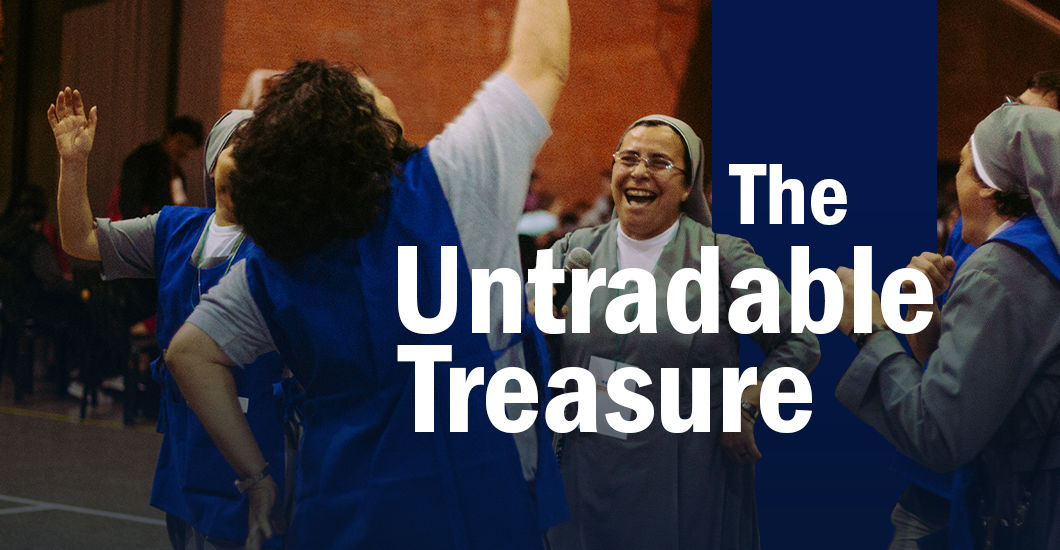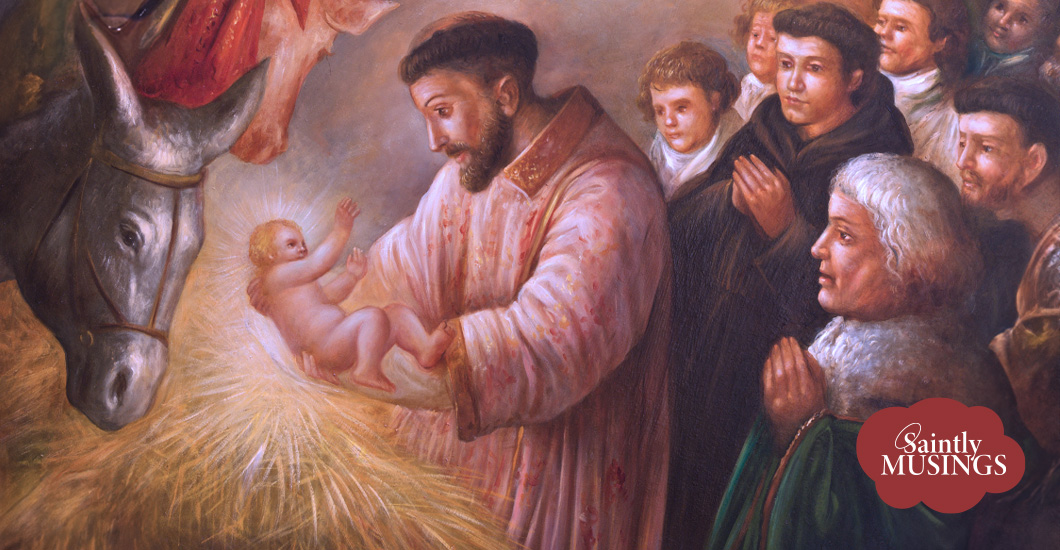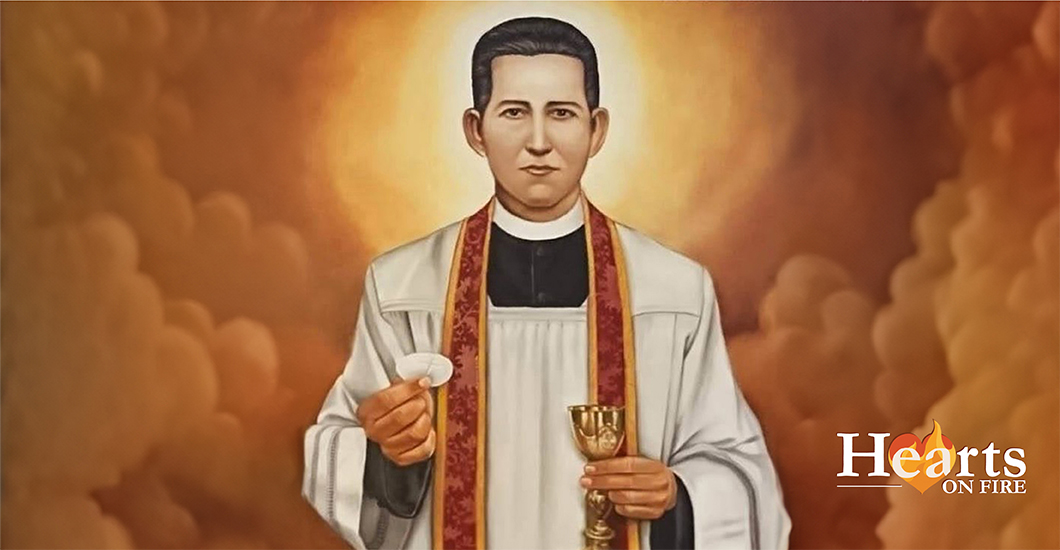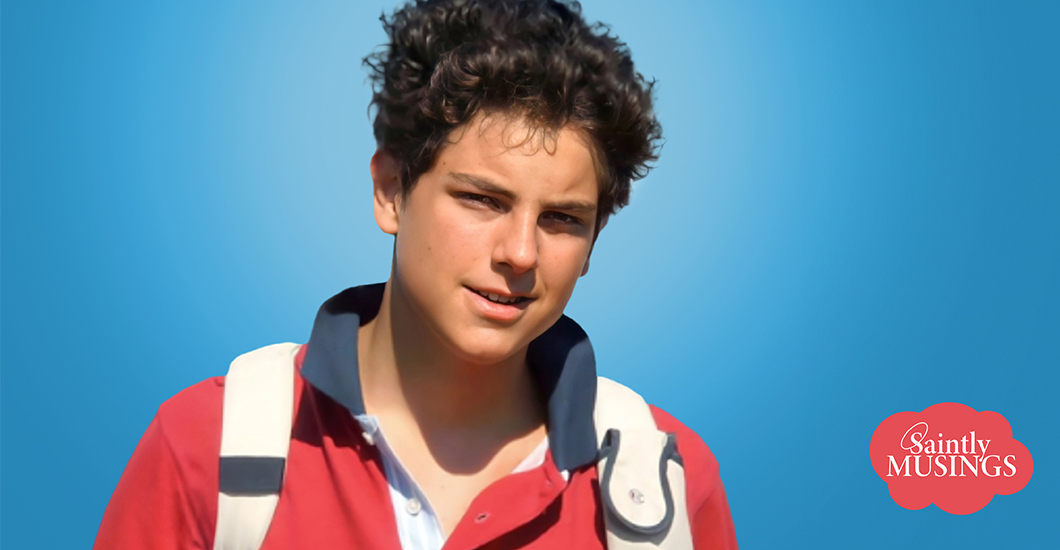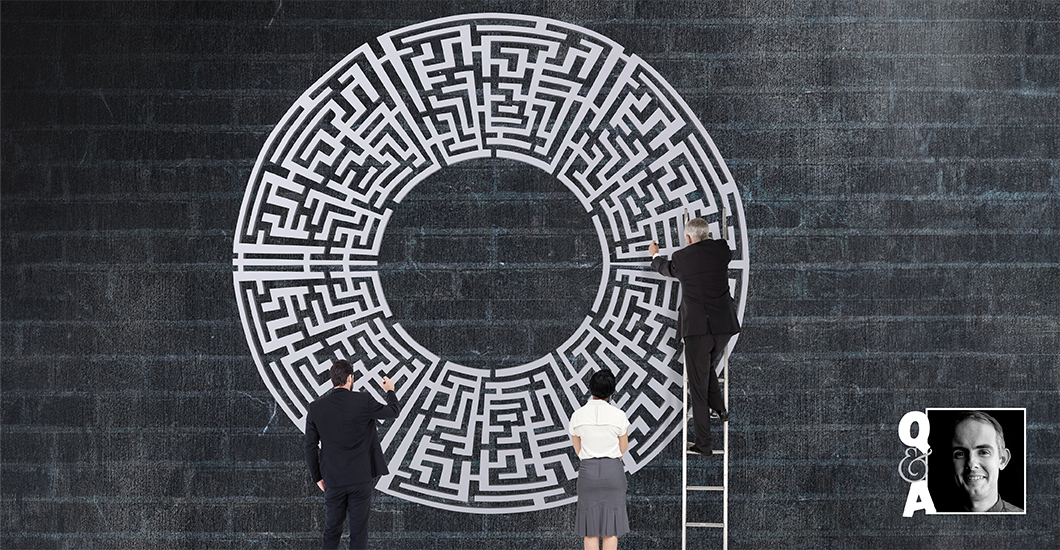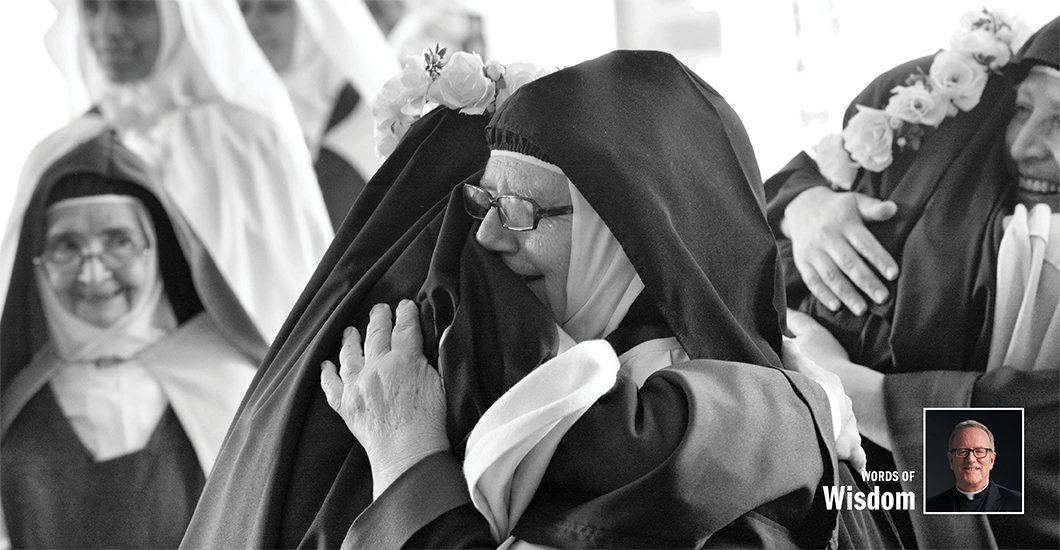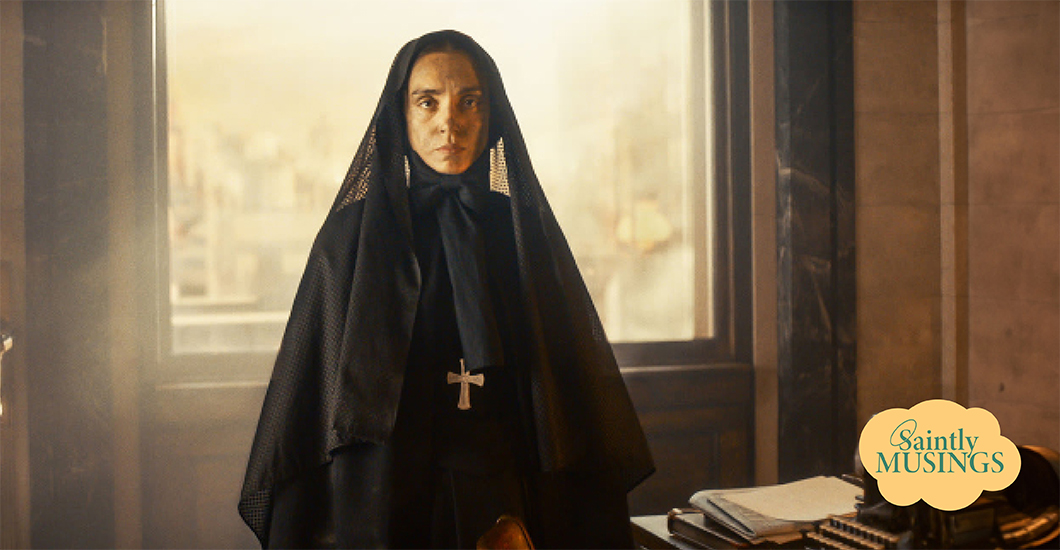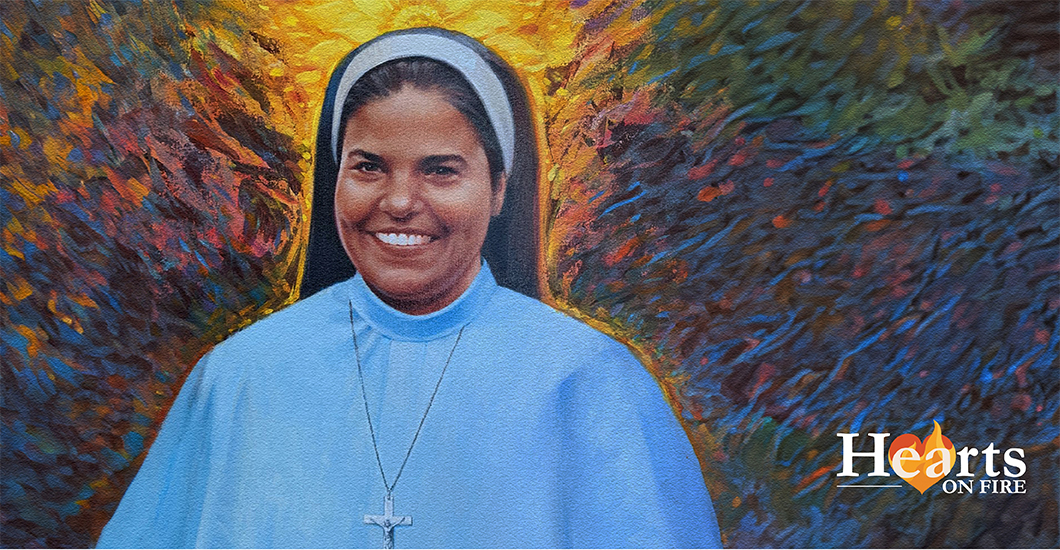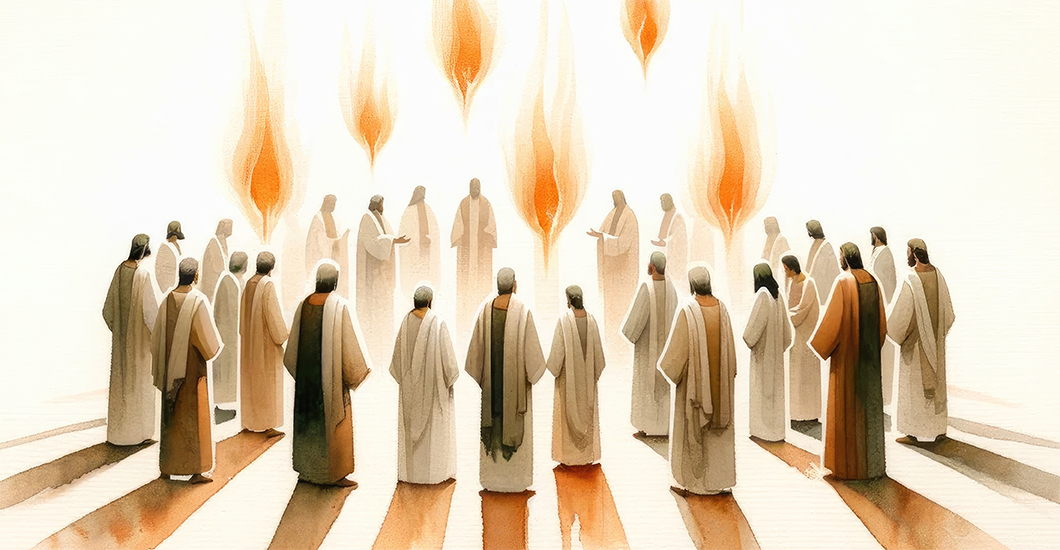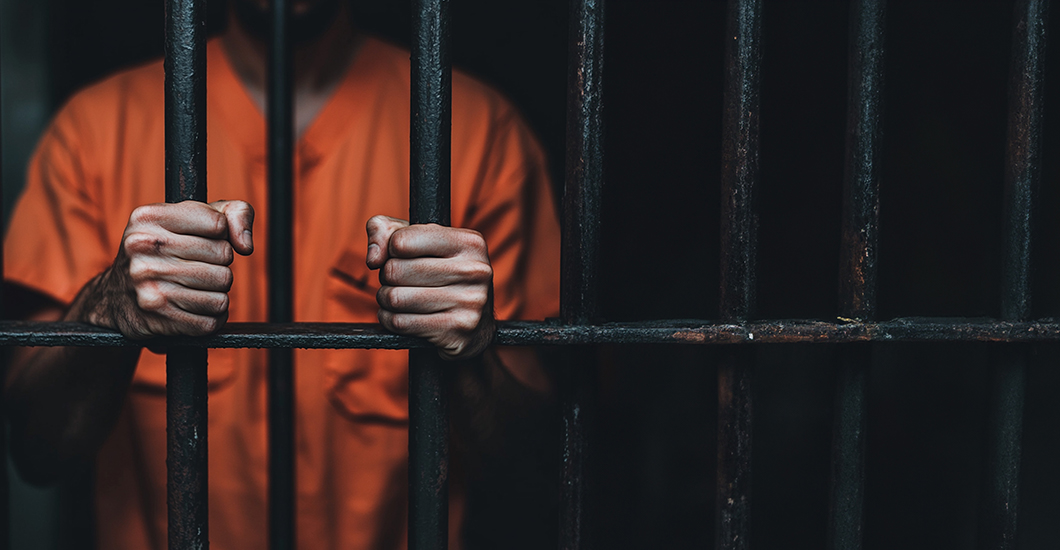Trending Articles
The Untradable Treasure
Begin a new today and change your life forever!
All These Years
After nine years of formation, I recently professed final vows as a Sister of the Holy Family of Nazareth. Following communion during the final vows Mass I was overcome with emotion and deep gratitude. It was as if God gifted me with a greater awareness of all that he had been accomplishing in me over the years. The gifts and graces of each prayer, confession, and reception of the Eucharist became present in that moment. I was amazed by God’s enduring, relentless love. As I knelt in prayer, I thought about how I was one of the unlikeliest candidates to become a spouse of Christ. “But nothing,” I remembered, “is impossible with God.”
I had grown up Baptist in Houston, Texas. When I was eight years old, my father died by suicide after years of struggling with addiction and because my mother was not able to care for us, my brothers and I were adopted by my aunt and uncle. The next ten years provided a consistency and stability I had never known in the first eight years of my life. I went to good schools, read books, played soccer, sang in the Church and school choirs, and got to be a regular kid.
When I was eighteen a pamphlet advertising a Dallas, Texas school for “independent thinkers” brought me to the University of Dallas. The fact it was Catholic totally escaped me. I spent much of my four college years indulging in sinful behaviors as a way of medicating my old wounds. I had no idea what to do with the pain that come from abandonment. My conscience was being formed at the University of Dallas. I spent a semester in Rome and encountered Pope Saint John Paul II whom I loved. His understanding of God resonated deeply in me. I joined a Latin liturgical choir and became more familiar with the Mass by singing at hundreds of eucharistic liturgies.
Made for Another World
After graduation my life was mostly work during the day and bars or hanging out with friends at night. I eventually sensed something was missing; for “if no worldly experience can satisfy my desires, then probably I was created for more than just this world.” That’s when I started seeking deeper faith. I wanted to be like the godly women who raised me. To my surprise, when it came time to decide where I would go to church, I found myself hungering for the Mass. I hesitated to become Catholic because there were so few Black Americans in the church. But the desire to receive Jesus in the Eucharist pulled me into the church.
Becoming Catholic didn’t fix everything. I still indulged in sinful behaviors, but I found myself constantly at confession. I was struggling emotionally and spiritually. Though I felt like I was killing myself spiritually (and physically–my weight was approaching 400 pounds), in my professional life I was reaching heights I had never imagined. During that struggle, I returned to Rome and went to confession and Mass at Saint Peter’s. My confessor’s advice that day to “just begin” changed everything. Within the year I was discerning a religious vocation, and three years after that confession I became a candidate with the Sisters of the Holy Family of Nazareth.
A Love Affair
Eleven years after that confession I said yes to Jesus in a way I did not know was possible. My wounds and shame had me making an all-too-common mistake which C.S. Lewis explains well: “We are half-hearted creatures, fooling about with drink and sex and ambition, when infinite joy is offered us, like an ignorant child who wants to go on making mud pies in a slum because he cannot imagine what is meant by the offer of a holiday at the sea. We are far too easily pleased.” Not only was I too easily pleased, but I made the mistake of seeing my life in light of the struggle instead of in light of the one who loves me.
During my postulancy, a Sister in her seventies who was giving a class on the spiritual life said, “I love my age. I would never want to be younger and I would never want to go back. I have all these years with Jesus. I have all these experiences. I would not want to trade that.” Surely, she had known loss, mistakes, and sin, but mingled in all that was an abiding love of Jesus that made her life a love affair with Jesus and an untradable treasure.
Gift of Tears
On the day of my final vows, my tears mingled a tinge of grief with a great sense of joy and gratitude. Throughout my life, as I experienced loss, pain, struggle and sin, joy remained inevitable because of Christ’s self-sacrificing love made manifest in the Eucharist. I have come to know that the final word in all our stories is Christ himself. Saint John says, “that which was from the beginning, which we have heard, which we have seen with our eyes, which we have looked upon and touched with our hands… we saw it and testify to it.”
My tears on that day of my final vows gave witness to the enduring love of Christ, come what may, through all these years.
Sister Josephine Garrett is studying to be a Clinical Mental Health Counselor. She served for 10 years as a Vice President in the Home Loans division of Bank of America. In 2005 she entered the Catholic Church, and in 2011 began her formation to be a Religious Sister with the Sisters of the Holy Family of Nazareth. Today Sister Josephine serves in vocations ministry, and also as a speaker for youth and young adult retreats and conferences.
Related Articles
The greatest evangelist is, of course, Jesus himself, and there is no better presentation of Jesus’ evangelical technique than Luke’s masterful narrative concerning the disciples on the road to Emmaus. The story opens with two people going the wrong way. In Luke’s Gospel, Jerusalem is the spiritual center of gravity— it is the locale of the Last Supper, the Cross, the Resurrection and the sending of the Spirit. It is the charged place where the drama of Salvation unfolds. So in walking away from the capital city, these two erstwhile disciples of Jesus are going against the grain. Jesus joins them on their journey—though we are told that they are prevented from recognizing Him—and He asks them what they are talking about. Throughout His ministry, Jesus associated with sinners. He stood shoulder to shoulder in the muddy waters of the Jordan with those seeking forgiveness through the baptism of John; over and again, He ate and drank with disreputable types, much to the chagrin of the self-righteous; and at the end of His life, He was crucified in between two thieves. Jesus hated sin, but He liked sinners and was consistently willing to move into their world and to engage them on their terms. And this is a first great evangelical lesson. The successful evangelist does not stand aloof from the experience of sinners, passing easy judgment on them, praying for them from a distance; on the contrary, she loves them so much that she joins them and deigns to walk in their shoes and to feel the texture of their experience. Prompted by Jesus’ curious questions, one of the travelers, Cleopas by name, recounts all of the 'things' concerning Jesus of Nazareth: “He was a prophet mighty in word and deed before God and all the people; our leaders, though, put Him to death; we thought He would be the redeemer of Israel; this very morning, there were reports that He had risen from the dead.” Cleopas has all of the 'facts' straight; there is not one thing he says about Jesus that is wrong. But his sadness and his flight from Jerusalem testify that he doesn’t see the picture. I love the clever and funny cartoons in the New Yorker magazine, but occasionally, there is a cartoon I just don’t understand. I’ve taken in all of the details, I’ve seen the main characters and the objects around them, I’ve understood the caption. Yet, I don’t see why it’s funny. And then there comes a moment of illumination: though I haven’t seen any further detail, though no new piece of the puzzle has emerged, I discern the pattern that connects them together in a meaningful way. In a word, I 'get' the cartoon. Having heard Cleopas’ account, Jesus say: “Oh, how foolish you are! How slow of heart to believe all that the prophets said.” And then He opens the Scriptures to them, disclosing the great Biblical patterns that make sense of the 'things' that they have witnessed. Without revealing to them any new detail about Himself, Jesus shows them the form, the overarching design, the meaning—and through this process they begin to 'get' Him: their hearts are burning within them. This is the second great evangelical lesson. The successful evangelist uses the Scriptures in order to disclose the divine patterns and ultimately the Pattern who is made flesh in Jesus. Without these clarifying forms, human life is a hodge-podge, a blur of events, a string of meaningless happenings. The effective evangelist is a man of the Bible, for the Scripture is the means by which we 'get' Jesus Christ and, through Him, our lives. The two disciples press Him to stay with them as they draw near the town of Emmaus. Jesus sits down with them, takes bread, says the blessing, breaks it and gives it to them, and in that moment they recognize Him. Though they were, through the mediation of Scripture, beginning to see, they still did not fully grasp who He was. But in the Eucharistic moment, in the breaking of the bread, their eyes are opened. The ultimate means by which we understand Jesus Christ is not the Scripture but the Eucharist, for the Eucharist is Christ Himself, personally and actively present. The embodiment of the paschal mystery, the Eucharist, is Jesus’ love for the world unto death, His journey into godforsakenness in order to save the most desperate of sinners, His heart broken open in compassion. And this is why it is through the lens of the Eucharist that Jesus comes most fully and vividly into focus. And thus we see the third great evangelical lesson. Successful evangelists are persons of the Eucharist. They are immersed in the rhythms of the Mass; they practice Eucharistic adoration; they draw the evangelized to a participation in the body and blood of Jesus. They know that bringing sinners to Jesus Christ is never primarily a matter of personal witness, or inspiring sermonizing, or even exposure to the patterns of the Scripture. It is primarily a matter of seeing the broken heart of God through the broken bread of the Eucharist. So prospective evangelists, do what Jesus did. Walk with sinners, open the Book, break the Bread.
By: Bishop Robert Barron
MoreI remember a childhood story in which God, about to destroy Earth because of humanity's wrongdoing, looked down, saw the lilies of the field praying for mankind, and extended the end of time. It was my wife's desire to attend daily Mass that led us to the nearby Carmelite Monastery. I was immediately struck by the pervasive stillness and a sense of tranquility. Through the grilled gates, these nuns looked like God's lilies on earth. As I was introduced to their daily life, I was surprised to learn that the sisters make vestments, altar breads, and greeting cards. They even stitch their own habits, grow their own fruits and vegetables, and look after the other elderly sisters. Most of the day is spent in silence, which helps them to open up to the Lord and pray. The sisters even meet up twice a day to talk and share. The power of prayer and its impact dawned upon me. The Church has a rich tradition of prayer, through which we deeply connect with God, whether it's through attending Mass, reciting the Rosary, or simply taking a few moments to reflect on God's presence in our lives. The experience of visiting the Carmelite Monastery was truly humbling. It helped me reflect on the power of prayer and the importance of dedicating one's life to serving others, and left me with a sense of peace and renewed faith.
By: Winner Varghese
MoreThe Mexican Revolution which began in the early 1920s, led to the persecution of the Catholic community in that country. Pedro de Jesus Maldonado-Lucero was a seminarian at that time. Once he became a priest, despite the risk, he stood with his people. He tended to his flock during a terrible epidemic, founded new apostolic groups, reestablished associations, and ignited Eucharistic piety among his parishioners. Upon discovering his pastoral activities, the government deported him, but he managed to return and continue serving his flock, in hiding. One day, after hearing the confessions of the faithful, a gang of armed men busted his hiding place. Father Maldonado managed to grab a reliquary with Consecrated Hosts as they forced him out. The men forced him to walk barefoot throughout the town, as a crowd of the faithful followed him. The city mayor grabbed Father Maldonado's hair and dragged him toward the city hall. He was knocked to the ground, resulting in a skull fracture that popped out his left eye. He had managed to keep his grip on the pyx until this time, but now it fell out of his hands. One of the thugs took some Holy Hosts, and as he forcefully stuffed the hosts inside the priest’s mouth, he shouted: “Eat this and see if He can save you now.” Little did the soldier know that just the night before, during the Holy Hour, Father Maldonado had prayed that he would happily give his life for an end to the persecution ‘if only he would be allowed to take Communion before his death.’ The thugs left him for dead in a pool of his own blood. Some local women found him still breathing and rushed him to a nearby hospital. Father Pedro Maldonado was born into eternal life the next day, on the 19th anniversary of his priestly ordination. Pope John Paul II canonized this Mexican priest in 2000.
By: Shalom Tidings
MoreWhen Andrea Acutis arranged a pilgrimage to Jerusalem, he thought that his son would be excited. Carlo was keen on going to daily Mass and reciting his prayers, so his reply came as a surprise: "I prefer to stay in Milan … Since Jesus remains with us always, in the Consecrated Host, what need is there to make a pilgrimage to Jerusalem to visit the places where He lived 2000 years ago? Instead, tabernacles ought to be visited with the same devotion!" Andrea was struck by this great devotion that his son cherished for the Eucharist. Carlo was born in 1991, the year the World Wide Web was invented. The little genius walked when he was just four months old, and started reading and writing at the age of three. The world would’ve looked at his intellect and dreamt of a bright future but the Divine had different plans. Combining his love for the Eucharist and technology, he left the world a great legacy of a record of Eucharistic miracles from across the world. He began the collection in 2002 when he was just 11 years old and completed it a year before he succumbed to leukemia. This young computer geek, at such a young age, even built a website (carloacutis.com), a lasting record, with all the collected information. The Eucharistic exhibition he pioneered was held in five continents. Ever since, many miracles have been reported. On his website, he has written the lasting mission of his life on Earth: "The more Eucharist we receive, the more we will become like Jesus, so that on this Earth, we will have a foretaste of Heaven." This Italian teenage designer and computer whiz is soon to become Saint Carlo Acutis. Widely known as the first millennial patron of the internet, Blessed Carlo continues to draw millions of youngsters to the love of Jesus in the Eucharist.
By: Shalom Tidings
MoreWhen she lost her mobility, eyesight, listening, voice, and even the sense of touch, what prompted this young girl to describe her life as ‘sweet?’ Little Benedetta, at age seven, wrote in her diary: “The universe is enchanting! It is great to be alive.” This intelligent and happy lass, unfortunately, contracted polio in her childhood, which left her body crippled, but nothing could cripple her spirit! Hard Times on Roll Benedetta Bianchi Porro was born in Forlì, Italy, in 1936. As a teenager, she began to go deaf, but despite this, she entered medical school, where she excelled, taking oral exams by reading the lips of her professors. She had an ardent desire to become a missionary doctor, but after five years of medical training and just one year short of completing her degree, she was forced to end her studies due to increasing illness. Benedetta diagnosed herself with neurofibromatosis. There are several iterations of this cruel disease, and in Benedetta’s case, it attacked the nerve centers of her body, forming tumors on them and gradually causing total deafness, blindness, and later, paralysis. As Benedetta’s world shrank, she demonstrated extraordinary courage and holiness and was visited by many who sought her counsel and intercession. She was able to communicate when her mother would sign the Italian alphabet into her left palm, one of the few areas of her body that remained functional. Her mother would sign letters, messages, and Scripture painstakingly into Benedetta’s palm, and Benedetta would reply verbally despite her voice having been weakened to a whisper. “They’d come and go in groups of ten and fifteen,” said Maria Grazia, one of Benedetta’s closest confidantes. “With her mother as interpreter, she was able to communicate with each one. It seemed as though she could read our innermost souls with extreme clarity, even though she couldn’t hear or see us. I will always remember her with her hand extended ready to receive the Word of God and her brothers and sisters.” (Beyond Silence, Life Diary Letters of Benedetta Bianchi Porro) It’s not that Benedetta never experienced agony or even anger at this disease that was robbing her of the ability to become a medical doctor, but in accepting it, she became a doctor of another sort, a kind of surgeon to the soul. She was, indeed, a spiritual doctor. In the end, Benedetta was no less a healer than she ever desired to be. Her life had shrunken all the way down to the palm of her hand, it was no bigger than a Communion host—and yet, just like a Blessed Communion Host, it had become more powerful than she would have ever imagined. It is impossible to miss the correlation between Benedetta’s life and Jesus in the Blessed Sacrament who is hidden and small too, silent and even weak, but an ever-present friend to us. Towards the end of her life, she wrote to a young man who suffered similarly: “Because I'm deaf and blind, things have become complicated for me … Nevertheless, in my Calvary, I do not lack hope. I know that at the end of the road, Jesus is waiting for me. First in my armchair, and now in my bed where I now stay, I have found wisdom greater than that of men—I have discovered that God exists, that He is love, faithfulness, joy, certitude, to the end of the ages … My days are not easy. They are hard. But sweet because Jesus is with me, with my sufferings, and He gives me His sweetness in my loneliness and light in the darkness. He smiles at me and accepts my collaboration.” (Venerable Benedetta Biancho Porro, by Dom Antoine Marie, OSB) A Compelling Reminder Benedetta passed away on January 23, 1964. She was 27 years old. She was venerated on December 23, 1993, by Pope John Paul II and beatified on September 14, 2019, by Pope Francis. One of the great gifts that the Saints bring to the Church is that they give us a clear picture of what virtue looks like, even in incredibly difficult circumstances. We need to ‘see ourselves’ in the lives of the Saints in order to be strengthened for our own. Blessed Benedetta is truly a model of sanctity for our times. She is a compelling reminder that even a life filled with serious limitations can be a powerful catalyst for hope and conversion in the world and that the Lord knows and fulfills the deepest desire of every heart, often in surprising ways. A Prayer to Blessed Benedetta Blessed Benedetta, your world became as small as a communion wafer. You were immobilized, deaf, and blind, and yet you were a powerful witness to the love of God and the Blessed Mother. Jesus in the Blessed Sacrament is hidden and small too, silent, immobilized, and even weak—and still all-powerful, ever present to us. Please pray for me, Benedetta, that I will collaborate, as you did, with Jesus, in whatever way He wishes to use me. May I be granted the grace to allow the Almighty Father to speak through my littleness and loneliness, too, for the glory of God and the salvation of souls. Amen.
By: Liz Kelly Stanchina
MoreQ - My many Christian friends celebrate ‘Communion’ every Sunday, and they argue that the Eucharistic presence of Christ is only spiritual. I believe Christ is present in the Eucharist, but is there any way to explain it to them? A – It is indeed an incredible claim to say that at every Mass, a small piece of bread and a small chalice of wine become the very flesh and blood of God Himself. It is not a sign or a symbol, but truly the body, blood, soul, and divinity of Jesus. How can we make this claim? There are three reasons why we believe this. First, Jesus Christ said so Himself. In John’s Gospel, Chapter 6, Jesus says: “Amen, amen, I say to you, unless you eat the flesh of the Son of Man and drink His blood, you do not have life within you. Whoever eats My flesh and drinks My blood has eternal life, and I will raise him on the last day. For My flesh is true food, and My blood is true drink. Whoever eats My flesh and drinks My blood remains in Me and I in him.” Whenever Jesus says, “Amen, Amen, I say to you…”, this is a sign that what He is about to say is completely literal. Further, Jesus uses the Greek word trogon which is translated ‘to eat’—but really means ‘to chew, gnaw, or rip with one’s teeth.’ It’s a very graphic verb which can only be used literally. Also, consider the reaction of His hearers; they walked away! It says in John 6: “as a result of this [teaching], many of His disciples returned to their former way of life and no longer accompanied Him.” Does Jesus chase them down, tell them that they misunderstood Him? No, He allows them to leave—because He was serious about this teaching that the Eucharist is truly His flesh and blood! Second, we believe because the Church has always taught it from its earliest days. I once asked a priest why there was no mention of the Eucharist in the Creed which we profess every Sunday—and he replied that it was because no one debated His Real Presence, so it wasn’t necessary to officially define it! Many of the Church Fathers wrote about the Eucharist—for example, Saint Justin Martyr, writing around the year 150 AD, penned these words: “For not as common bread and common drink do we receive these; but we have been taught that the food which is blessed by the prayer of His word, and from which our blood and flesh are nourished, is the flesh and blood of that Jesus who was made flesh.” Every Church Father is in agreement—the Eucharist is truly His flesh and blood. Finally, our faith is strengthened through the many Eucharistic miracles in the history of the Church—over 150 officially documented miracles. Perhaps the most famous occurred in Lanciano, Italy in the 800s, where a priest who doubted Christ’s presence was shocked to find that the Host became visible flesh, while the wine became visible as blood. Later scientific tests discovered that the Host was heart flesh from a human male, type AB blood (very common among Jewish men). The heart flesh had been badly beaten and bruised. The blood had congealed into five clumps, symbolizing the five wounds of Christ, and miraculously the weight of one of the clumps is equal to the weight of all five taken together! Scientists cannot explain how this flesh and blood has lasted for twelve hundred years, which is an inexplicable miracle in itself. But how can we explain how this happens? We make a distinction between accidents (what something looks like, smells like, tastes like, etc) and substance (what something actually is). When I was a young child, I was at my friend’s house, and when she left the room, I saw a cookie sitting on a plate. It looked delectable, smelled like vanilla, and so I took a bite…and it was soap! I was so disappointed, but it taught me that my senses could not always decipher what something actually is. In the Eucharist, the substance of bread and wine change into the substance of Christ’s body and blood (a process known as transubstantiation), while the accidents (the taste, smell, look) remain the same. It does indeed take faith to recognize that Jesus is truly present, since it cannot be perceived by our senses, nor is it something we can deduce with our logic and reason. But if Jesus Christ is God and He cannot lie, I am willing to believe that He is not a sign or symbol, but truly present in the Most Blessed Sacrament!
By: Father Joseph Gill
MoreMy new hero is Mother Alfred Moes. I realize that she is not a household name, even among Catholics, but she should be. She came on my radar screen only after I became the Bishop of the Diocese of Winona-Rochester, where Mother Alfred did most of her work and where she lies buried. Hers is a story of remarkable courage, faith, perseverance, and sheer moxie. Trust me, once you take in the details of her adventures, you will be put in mind of a number of other gritty Catholic Mothers: Cabrini, Teresa, Drexel, and Angelica, to name a few. Mother Alfred was born Maria Catherine Moes in Luxembourg in 1828. As a young girl, she became fascinated by the possibility of doing missionary work among the native peoples of North America. Accordingly, she journeyed with her sister to the New World in 1851. First, she joined the School Sisters of Notre Dame in Milwaukee but then transferred to the Holy Cross Sisters in La Porte, Indiana, a group associated with Father Sorin, CSC, the founder of the University of Notre Dame. After clashing with her superiors—a rather typical happenstance for this very feisty and confident lady—she made her way to Joliet, Illinois, where she became superior of a new congregation of Franciscan sisters, taking the name ‘Mother Alfred.’ When Bishop Foley of Chicago tried to interfere with the finances and building projects of her community, she set out for greener pastures in Minnesota, where the great Archbishop Ireland took her in and allowed her to establish a school in Rochester. It was in that tiny town in southern Minnesota that God commenced to work powerfully through her. In 1883, a terrible tornado tore through Rochester, killing many and leaving many others homeless and destitute. A local doctor, William Worrall Mayo, undertook the task of caring for the victims of the disaster. Overwhelmed by the number of injured, he called upon Mother Alfred’s sisters to help him. Though they were teachers rather than nurses and had no formal training in medicine, they accepted the mission. In the wake of the debacle, Mother calmly informed Doctor Mayo that she had a vision that a hospital should be built in Rochester, not simply to serve that local community, but rather the whole world. Astonished by this utterly unrealistic proposal, Doctor Mayo told Mother that she would need to raise $40,000 (an astronomical figure for that time and place) in order to build such a facility. She in turn told the doctor that if she managed to raise the funds and build the hospital, she expected him and his two physician sons to staff the place. Within a short span of time, she procured the money, and the Saint Mary’s Hospital was established. As I’m sure you’ve already surmised, this was the seed from which the mighty Mayo Clinic would grow, a hospital system that indeed, as Mother Alfred envisioned long ago, serves the entire world. This intrepid nun continued her work as builder, organizer, and administrator, not only of the hospital that she had founded, but of a number of other institutions in southern Minnesota until her death in 1899 at the age of seventy-one. Just a few weeks ago, I wrote about the pressing need in our diocese for priests, and I urged everyone to become part of a mission to increase vocations to the priesthood. With Mother Alfred in mind, might I take the occasion now to call for more vocations to women’s religious life? Somehow the last three generations of women have tended to see religious life as unworthy of their consideration. The number of nuns has plummeted since the Second Vatican Council, and most Catholics, when asked about this, would probably say that being a religious sister is just not a viable prospect in our feminist age. Nonsense! Mother Alfred left her home as a very young woman, crossed the ocean to a foreign land, became a religious, followed her instincts and sense of mission, even when this brought her into conflict with powerful superiors, including a number of Bishops, inspired Doctor Mayo to establish the most impressive medical center on the planet, and presided over the development of an order of sisters who went on to build and staff numerous institutions of healing and teaching. She was a woman of extraordinary intelligence, drive, passion, courage, and inventiveness. If someone had suggested to her that she was living a life unworthy of her gifts or beneath her dignity, I imagine she would have a few choice words in response. You’re looking for a feminist hero? You can keep Gloria Steinem; I’ll take Mother Alfred any day of the week. So, if you know a young woman who would make a good religious, who is marked by smarts, energy, creativity, and get-up-and-go, share with her the story of Mother Alfred Moes. And tell her that she might aspire to that same kind of heroism.
By: Bishop Robert Barron
MoreIn the early 1900s, Pope Leo XIII requested the congregation of Missionary Sisters of the Sacred Heart to go to the United States to minister to the significant number of Italian immigrants there. The congregation’s founder, Mother Cabrini, desired to do a mission in China, but obediently heeded the Church’s call and embarked on a long journey across the sea. As she had nearly drowned as a child, she formed a great fear of water. Still, in obedience, she...across the sea. On arrival, she and her sisters found that their financial aid had not been sanctioned, and they had no place to live. These faithful daughters of the Sacred Heart persevered and began serving the people on the margins. In a few years, her mission among the immigrants flourished so fruitfully that till her passing, this aquaphobic nun made 23 transatlantic trips around the world, founding educational and healthcare facilities in France, Spain, Great Britain, and South America. Her obedience and attentiveness to the Church’s missionary call was eternally rewarded. Today, the Church venerates her as the patron saint of immigrants and hospital administrators.
By: Shalom Tidings
MoreRani Maria Vattalil was born on 29 January 1954 to Eleeswa and Paily Vattalil in a small village called Pulluvazhy, in Kerala, India. From a young age, she was brought up in the Christian faith, having love for the poor. She attended daily Mass and led family prayers. During the final year of high school, Rani felt the Lord calling her to consecrated life and entered the Franciscan Clarist Congregation in 1972. It was Rani Maria’s ardent desire to do missionary work in North India and serve the poor, even if it cost her life. She was sent to Madhya Pradesh (a central Indian state) and served several mission areas there. Sister Rani Maria was given the responsibility of coordinating the social apostolate of the local diocese. She organized various educational programs for children and young people and worked relentlessly to empower the indigenous people. She understood how the poor, illiterate farmers were exploited and taken advantage of by their landlords. So, she educated them on their rights, helped them fight for justice, and spoke for those who were unjustly imprisoned. All this infuriated the upperclass landlords, who threatened her with dire consequences if she continued supporting the cause of the poor. But Rani Maria feared nothing and did not back down from her mission to 'love her neighbor.' A devious plan was then hatched by those who hated her. On 25th February 1995, while traveling by bus, she was mercilessly stabbed 54 times by Samundhar Singh—a man hired by the landlords. She breathed her last, repeating the Holy name of Jesus. Rani Maria worked her entire life to fight for the dignity and rights of her fellow men and bore witness to the Gospel through her social activities. Sister Rani Maria’s family, following the valiant example of their daughter, forgave her murderer wholeheartedly, even inviting him to their home! This act of mercy touched him deeply; he repented of his heinous crime and became a changed man. Sister Rani Maria was beatified by Pope Francis on 4th November 2017.
By: Shalom Tidings
MoreWherever you are and whatever you do, you are irrevocably called to this great mission in life. In the mid-eighties, Australian director Peter Weir made his first American film, a successful thriller, Witness, which starred Harrison Ford. The movie is about a young boy who sees the murder of an undercover police officer by corrupt co-workers, and he’s hidden away in an Amish community for protection. As the story unfolds, he recalls what happened by putting the pieces together and then, he tells the Ford character named John Book (note the Gospel symbolism). The movie contains the marks of a witness: one sees, recalls, and tells. Circling Back Jesus showed Himself to His innermost circle so that the truth of His Resurrection would reach everyone through them. He opened the minds of His disciples to the mystery of His Death and Resurrection saying: “You are witness to these things” (Luke 24:48). Having seen Him with their own eyes, the Apostles could not remain silent about this incredible experience. What’s true for the Apostles is also true for us because we are members of the Church, the mystical Body of Christ. Jesus commissioned his disciples to “Go, therefore, and make disciples of all nations, baptizing them in the name of the Father, and of the Son, and of the Holy Spirit.” (Matthew 28:19) As missionary disciples, we testify that Jesus is alive. The only way we can enthusiastically and steadfastly embrace this Mission is to see through the eyes of faith that Jesus is Risen, that He is alive, and present within and among us. That’s what a witness does. Circling back, how does one ‘see’ the Risen Christ? Jesus instructed us: “Unless a grain of wheat falls into the earth and dies, it remains alone; but if it dies, it bears much fruit.” (John 12:23-24) Put simply, if we really want to ‘see’ Jesus, if we want to know Him deeply and personally, and if we want to understand Him, we have to look to the grain of wheat that dies in the soil: in other words, we have to look to the Cross. The Sign of the Cross marks a radical shift from self-reference (Ego-drama) to being Christ-centered (Theo-drama). In itself, the Cross can only express love, service, and unreserved self-giving. It is only through sacrificial giving of the self for the praise and glory of God and the good of others that we can see Christ and enter Trinitarian Love. Only in this way can we be grafted onto the ‘Tree of Life’ and truly ‘see’ Jesus. Jesus is Life itself. And we are hard-wired to seek Life because we are made in God’s image. That’s why we’re drawn to Jesus—to ‘see’ Jesus, meet Him, know Him, and fall in love with Him. That’s the only way we can be effective witnesses to the Risen Christ. The Hidden Seed We too must respond with the witness of a life that is given in service, a life that is patterned after the Way of Jesus, which is a life of sacrificial self-giving for the good of others, recalling that the Lord came to us as servants. Practically speaking, how can we live such a radical life? Jesus told His disciples: “You will receive power when the Holy Spirit has come upon you; and you will be My witnesses.” (Acts 1:8) The Holy Spirit, just as He did at the first Pentecost, frees our hearts chained by fear. He overcomes our resistance to do our Father’s will, and He empowers us to give witness that Jesus is Risen, He is alive and He is present now and forever! How does the Holy Spirit do this? By renewing our hearts, pardoning our sins, and infusing us with the seven gifts that enable us to follow the Way of Jesus. It is only through the Cross of the hidden seed, ready to die, that we can truly ‘see’ Jesus and therefore give witness to Him. It is only through this intertwining of death and life that we can experience the joy and fruitfulness of a love that flows from the heart of the Risen Christ. It is only through the power of the Spirit that we reach the fullness of the Life He gifted us with. So, as we celebrate Pentecost, let us resolve by the gift of Faith to be witnesses of the Risen Lord and bring the Paschal gifts of joy and peace to the people we encounter. Alleluia!
By: Deacon Jim McFadden
MoreLatest Articles
My dog enjoys going for walks, but he wants to be in control. He doesn’t pay attention to my cues. He doesn’t care where I want to go; instead, he goes wherever he wants to. I keep him on a short leash because he tends to chase after cars. If I allowed him to do whatever he wanted, he would get hurt. My dog is stubborn. He pulls and tugs with all his strength. He doesn’t understand that I am only trying to protect him. I wonder if I am as unyielding as my dog. The Lord guides me along the best pathway for my life. He advises and watches over me. Yet, sometimes, I am like a senseless animal that needs a bit and bridle to be kept in check. I feel I know what is best for me. I don’t want to wait for God’s timing. I want to chase my desires and follow my impulses. I am reluctant to stay calmly by God’s side and seek His will in all things. Lord, train me to yield to You. Teach me to trust that You know what is best although it may not be what I want. Help me want to please You more than anything else. May I enjoy walking by Your side faithfully and attentively as You lead me along the best pathway for my life.
By: Nisha Peters
MoreAdulthood is scary, but with the right company, you can learn to thrive in grace and strength! Jesus treasured friendship and hand-picked 12 men to walk closely with Him and learn from Him. Of course, there were also women friends. Remember the sisters, Mary and Martha? And Mary Magdalene? The fact that the Gospels mention these friendships reveals that the people in the fabric of our lives are very important. Jesus even called His disciples friends! “I no longer call you servants, because a servant does not know his master’s business. Instead, I have called you friends, for everything that I learned from my Father I have made known to you.” (John 15:15) It is an honor and elevation to be called a friend of His! In the same way, it’s important for us to recognize that being a friend to one another is an honor. It is a role to be taken seriously. As Jesus reminds us: “Whatever you did for one of the least of these brothers and sisters of mine, you did for me.”(Matthew 25:40) Your presence, or lack of it, is impactful to another. Your actions, support, and prayers can make an immense imprint on the life of another person. It is a role to steward well, as with any of the roles we have been entrusted. A Gift Par Excellence In adulthood, many lament at the lack of friendship or the difficulty of making friends. The ache of a heart longing for dear friends is very real. Friendship is truly a gift, a gift that one should most definitely pray for. The impact of true Christian friendship on a person’s life is very deep. So it is important to carefully ‘choose’ the people with whom you entrust this title. A friend who does not share the same values can be closer to an enemy. Proverbs 27:17 reminds us: “As iron sharpens iron, so one person sharpens another.” The lives of the Saints are a constant encouragement as we often hear about one Saint being friends with another! Saint Francis and Saint Clare are often talked about as friends who partnered in purpose and spirituality, enriching one another's lives. So were Saint Teresa of Avila and Saint John of the Cross. Saint John Paul II and Mother Teresa are 20th-century models. True friends will spur us on to become the best versions of ourselves. Led by Faith I attribute much of my growth and life successes to being surrounded by the right friends. The people closest to me have a clear spiritual vision. They have provided encouragement right on time, and I know that they are always available for prayer support, whether that be interceding for me in their own time or dropping everything to pray with me. A Christ-focused friend will often know when you need prayers. I have a friend who can sense the area of my life that I need prayers for. She often shares what the Holy Spirit has told her in prayer. Conversations with her are always encouraging and they provide me with strength and confirmation. I can recall numerous times when a friend sent a Scripture verse right on time or a word from the Holy Spirit that resonated perfectly with me. On too many occasions to count, I’ve had a text message from a friend letting me know that they felt led to pray for me. These mostly come when I am in the midst of making very large life decisions or facing some huge internal struggle. There was a time when I felt very stuck in life; it seemed that I was making no progress. A dear friend sent me a Word that they believed God was doing something very special behind the scenes in my life. I felt the strength to go on and realized that God was up to something, even though I was feeling discouraged. Days after that, things started clicking into place–desires that I had prayed for over many years began to manifest in my life! A true friend will be willing to intercede with and for you as you fight your battles. They will celebrate the victories of God in your life and be concerned for your spiritual welfare more than any other aspects of your life. But remember, there are also times when you will need to let a friend know that you are in need of prayers. I know that my life would look very different if it were not for my friends who are in tune with the Holy Spirit. Walking with others on the same journey of surrendering to Christ has had clear benefits. A shared vision of aiming for Eternal life and holiness in this life is valuable in friendship. I’ve had the honor of being helped and helping friends carry their crosses in life, sharing joys, and praising God together. Enrich Your Life Are you in a period of life where you are longing for more friends? Pray to meet them! Keep your eyes open for the unexpected ways they come into your life. If you’re in a season of life where you have friends, but feel distant, start by sending a message or calling a friend who has been in your thoughts lately. Open your heart to friendship. Too many friendships have withered and never had a chance to fully blossom due to the busyness of one or both parties. Friendship, like any other relationship, requires sacrifices. It will look different in different seasons. Yet, it is a tremendous blessing and gift from God. Building and maintaining friendships is an investment. Enduring friendships can add so much enrichment and value to your life. Cherish the gift of a good friend, and treasure greatly the title of a friend when it is bestowed upon you. Jesus, please help us to be true and faithful friends to others. Send us the friends with whom we can walk steadily toward You. Amen!
By: Lianna Mueller
MoreChristmas is not just a day but a season of celebrating joy and hope. Hanging lights, stars, and Christmas trees make the occasion colorful, but it is undoubtedly incomplete without a nativity scene. Have you ever wondered how the tradition of staging the nativity scene began? Greccio, a small town in Italy, was home to peasants who led a peaceful agricultural life. More than 800 years ago, Brother Francis, returning from a pilgrimage to the Holy Land, obtained permission from Pope Honorius III to re-enact the birth of Jesus, the scene of which he had just visited. So on Christmas Eve of 1223, inside a cave in Greccio, villagers disguised as Saint Joseph and Mother Mary acted out the historical event that only Bethlehem had seen. Francis welcomed more life to the holy night act with a rag doll representing the Christ Child; he even brought an ox and a donkey, giving the villagers a visual treat. He then stood before the manger, full of devotion and piety, his face bathed in tears and radiant with joy; the Holy Gospel was chanted, and he preached about the nativity of the poor King. Unable to even utter His name for the tenderness of His love, Francis called Him the Babe of Bethlehem. Master John of Greccio, a valiant soldier and a dear friend of Brother Francis, who, for the love of Christ, had left the worldly affairs, witnessed Francis cradling a beautiful infant in his arms so gently as if he feared the baby might wake up. Doubtless, the baby was the Christ Child Himself because a trail of miracles followed the scene. It is said that the hay of that manger, being preserved by the people, miraculously cured the cattle of many diseases and other pestilences! Brother Francis turned out to be none other than Saint Francis of Assisi, one of the most famous Saints in the Church’s history, whose very name excites every heart with the compassionate love of Christ!
By: Shalom Tidings
MoreI told my best friend: “The Church could really use someone like you in this broken world…” Somewhere, it resonated deep. My best friend and I met three years ago. We didn't become very close right away because, for starters, Dave takes a good while to warm up to people, and more importantly, people here in prison are a lot more guarded than those on the outside. Over time, however, that all changed, and Dave has since become my closest ally. Not long after I met Dave, it became clear to him that I was very serious about my Catholic faith. I had a Crucifix and pictures of Saints hanging on the wall of my cell. I watched and participated in Mass on television, and to be honest, I brought the topic up quite frequently. At first, Dave didn't make any comments or show much interest in my faith; he would just politely nod his head and move on, but something was telling me that I shouldn't let that hinder me from sharing all about what I believed and telling stories about the miracles and peace that I'd received directly from being Catholic. Returning to the Roots As time progressed and I became closer to Dave, he began to open up a little bit more about his own faith. He told me he was a Christian but he hadn't really been to services in years, partly because he had been locked in a cell for so long, unable to move around the prison compound. But as I dug deeper, I found out, to my astonishment, that Dave was actually raised as a Catholic. Not only that, but he had received all three Rites of Initiation! I immediately began to ask him question after question and learned a lot more about him and his faith journey. Of the many things I discovered, one really stood out. To this very day, Dave has had a fascination with the Catholic knights of old. Because of that, the favorite church he had ever attended was a Catholic church that was round in shape, reminiscent of the Knights Templar churches. I could sense through this fascination that there was still some interest in the Church, even if it was just a small one. Talking to Dave about a possible return to his roots was not as promising, however. Let me be clear—he was never rude or aggressive, but he didn't seem to have any desire for the Sacraments. He was resigned to his habits, and they didn't include Catholicism, and unfortunately, the Church had all but forgotten about him. A Glimmer of Hope As the months went on, Dave would ask little questions about the Church. Nothing big, just showing a bit more interest as time ticked by. Of course, I didn't want to make him feel pressured, so I patiently and prayerfully continued my mission to bring him back to the Church. I could sense that there was more of a glimmer of hope than before and I would sometimes say to him: "You know Dave, the Church could really use someone like you in this broken world." He never would answer me, only musing over my words silently, but for Dave, a lot is said in his silence. A few weeks ago, a group of Catholic deacons came to visit with us in our cells. They brought Communion for Catholics, and literature for everyone, and went from cell to cell asking if people would like to pray with them. Sometime after they left, Dave came to my cell and told me about how one of the men had surprised him because they spoke about a particular round shaped church the man was a parishioner of. This happened to be the very same one Dave had gone to as a kid. He said the man had told him he hoped to see him there one day. The next thing Dave told me was a big surprise: "You know, I've been thinking about it, and I might like to go back to the Catholic Church." I was dumbfounded. I'd been waiting for this type of interest for literally three years, and I knew it was possible it would never come. I’d prayed for it time and again. I didn't know what to say. After a prolonged silence, I asked him: "Would you be interested in receiving Communion again?" He said he was. The Open Door At 15, Dave was charged as an adult and sentenced to life in prison. He is now 48. When he went to prison as a mere child, he tried to fit into a world of adult criminals. There's been plenty of violence and bloodshed in his story. Most people who go down his road are so jaded in the end that it seems nothing can bring them back, but now, Dave was interested. Praise God! Last week, Dave received Communion for the first time in 33 years. He had never once received Jesus in prison, though it had been available all the time. He had been forgotten in the system. Due to the impossibility of receiving the Sacrament of Reconciliation, he did not go to Confession first but was allowed to receive Communion circumstantially. He is in a maximum-security cell block and has the highest security risk rating, so they have trouble allowing a priest to visit one-on-one. So, he made a thorough examination of conscience and an act of contrition and will make a Confession at the first opportunity. Never Forgotten There are innumerable forgotten people all over the world. There are men, women, and even children in your own community who need someone to just be a friend and share their love and the faith Christ has given us in His Church. Let's continue to spread the Good News. If you have been away from the Church and Her life-giving Sacraments, there is an open invitation for healing starting with the Sacrament of Reconciliation. The first step back into fellowship with God and His Church is confessing our sins, but remember, while we are certainly confessing our sins to God, even more so, God is using this time to confess to us in a very special way, His forgiveness and love. Nothing is too big to be forgiven, and nothing is too great to stand in the way of God's healing; the door is always open to forgiveness and mercy. Contact a local church or parish priest and make plans to attend the next scheduled Sacrament of Reconciliation. Be sure to show up a little early in case others are waiting as well. You'll be glad you've made this step, and the Angels and Saints in Heaven will rejoice at your homecoming.
By: Jon Blanco
More